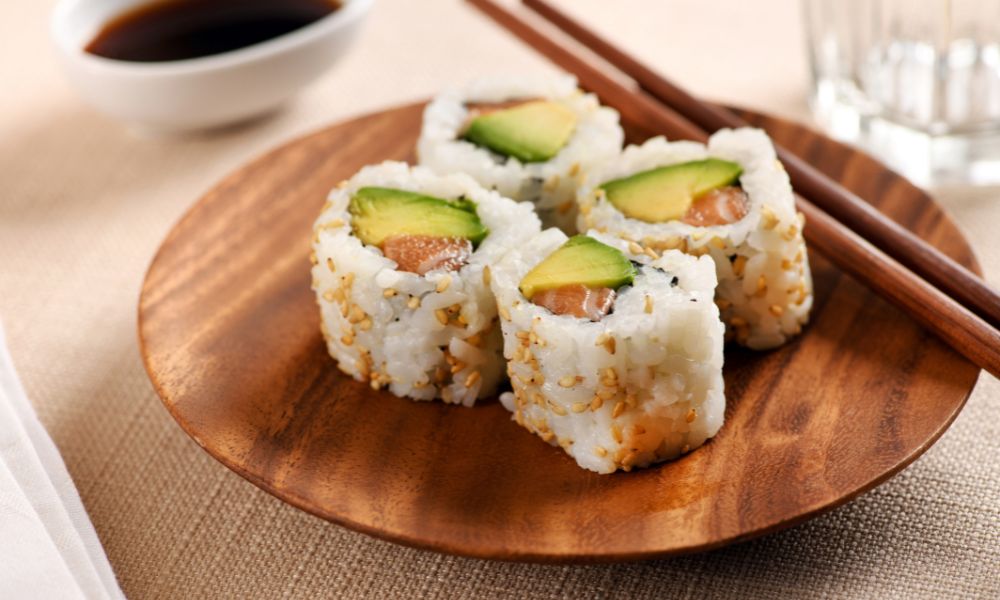The uramaki, also known as inverted sushi, is one of the most popular and creative variations of Japanese sushi. Unlike traditional sushi, where the rice is on the inside and the nori seaweed on the outside, in uramaki the seaweed is wrapped around the filling, while the rice is on the outside, covered with sesame seeds or fish. Uramaki is a delicious mix of crunchy, creamy and fresh textures, which guarantees a tasty and visually impressive dish.
Now we will teach you how to prepare the uramaki at home, exploring different combinations of ingredients to make sushi even tastier and more personalized. Let's go step by step!
Ingredients:
- 2 sheets of nori seaweed (dried seaweed)
- 1 cup Japanese sushi rice
- 1 tablespoon rice vinegar
- 1 tablespoon sugar
- 1/2 teaspoon salt
- 100g of fresh fish (salmon, tuna or fish of your choice)
- 1/4 Japanese cucumber (or regular cucumber), cut into thin strips
- 1/4 avocado, cut into thin strips
- 1 tablespoon sesame seeds (white or black) to coat the rice
- Soy sauce for serving
- Wasabi and pickled ginger (optional, to serve)
Directions:
1. Preparing Rice for Sushi:
- Rinse the Japanese rice in cold water until the water runs clear to remove excess starch. This step is essential to ensure that the rice is sticky and ideal for sushi.
- Cook the rice according to the package directions, usually in a 1:1 ratio of rice to water. After the rice is cooked, let it sit for about 10 minutes with the lid on.
- In a small bowl, mix the rice vinegar, sugar, and salt until well dissolved. Mix this mixture into the still-hot rice, stirring gently so that the rice absorbs the seasoning. Let the rice cool to room temperature before using.
2. Preparing the Filling Ingredients:
- Cut the fish into thin, even strips, about 1 to 1 1/2 inches (3 to 4 cm) long. Salmon and tuna are the most common choices for uramaki, but you can use other types of fish or even vegetables, such as carrots or cucumbers.
- Wash the cucumber and remove the seeds before cutting it into thin strips. If using avocado, cut it into equally thin strips.
3. Assembling the Uramaki:
- Place a sheet of nori seaweed on a bamboo mat (makisu), with the rough side facing up. This is the first step to ensure that the rice is on the outside and the seaweed is on the inside of the roll.
- With slightly moistened hands (to prevent the rice from sticking), spread a thin layer of rice over the seaweed, covering the entire surface but leaving a border of about 2 cm at the top (without rice). This space will be used to seal the roll at the end.
- Sprinkle the sesame seeds over the rice, making sure they are evenly distributed and adherent.
4. Turning the Seaweed and Adding the Filling:
- Turn the seaweed sheet with the rice side down so that the seaweed is facing up.
- Place the filling in the center of the seaweed. Typically, the filling consists of fish (salmon or tuna), cucumber strips, and avocado. You can add other ingredients, such as cream cheese, crab sticks, or even a touch of teriyaki sauce for added flavor.
5. Rolling the Uramaki:
- Start rolling the sushi using the bamboo mat. Lift the bottom end of the mat and, using your hands, gently roll it, pressing lightly so that the roll is firm, but without tightening too much so that the rice doesn't come loose.
- When you reach the end, moisten the top edge of the seaweed with a little water and press to seal the roll.
6. Cutting the Uramaki:
- Using a sharp knife (preferably a chef's knife), cut the uramaki roll into 6 to 8 pieces, depending on the desired size. Wipe the knife with a damp cloth between cuts to prevent the rice from sticking and ensure cleaner cuts.
- If necessary, cut the roll in half before cutting into smaller pieces to make the process easier.
7. Serving:
- Serve the uramaki with soy sauce, pickled ginger, and wasabi. The soy sauce is great for dipping the sushi pieces, while the ginger and wasabi add freshness and a hint of spice.
Tips for a Perfect Uramaki:
- Distribute the Rice Evenly: Don't overload the roll with rice. The key to a perfect uramaki is a thin, even layer of rice, so that the sushi is well-balanced and easy to roll.
- Use Fresh Ingredients: The flavor of your uramaki will depend largely on the quality of the ingredients. Use fresh fish from a good source and prepare the vegetables as fresh as possible to ensure tasty sushi.
- Sharp Knife: To cut the uramaki without breaking the rice, use a very sharp knife. Clean the knife between cuts to ensure that the pieces are well-formed and look flawless.
- Variety of Fillings: Don’t be afraid to get creative! In addition to fish and vegetables, you can add ingredients like cream cheese, crab sticks, or even fruits like mango for a sweet and savory combination.

